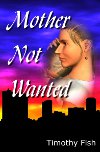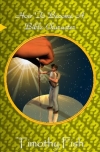
And Thy House
Extra Feature: High Res Image

History of
Cane Creek
Association
by D. F. Magruder
What BookSurge's New Prices Mean
Written By: Timothy Fish Published: 2/2/2008
In the Print On Demand business, there are a couple of major players, Lightning Source and BookSurge (owned by Amazon.com). If you have a book that is printed through a Publish On Demand publisher or a small traditional publisher, there is a strong possibility that your book comes from one of these two companies. While Lightning Source caters more to publishers, up to this point, BookSurge has offered services for authors, making it a kind of hybrid Print On Demand/Publish On Demand company. However, BookSurge has implemented policy changes in 2008.
When using Print On Demand, the most cost effective way for an author to make his book available to the public is by submitting a print-ready PDF. We will ignore the other services that Publish On Demand companies offer. They are just chatter. Through the end of 2007, the cost of publishing print-ready PDF through BookSurge was $99, less any discounts they might offer. As of 2008, the current price for the same service is $299, a 202% increase in initial cost.
Before you start to think that Amazon is just trying to rip people off with this price increase consider another policy change. Through January 2008, they royalty rate paid on books published through BookSurge was 25% of the list price. As of February 1, 2008, the rate is 35% of the list price. That extra 10% is a nice bonus for the authors who already have books in the BookSurge system and some people would say that they should have been getting higher rates to begin with, since the author is doing most of the work. The thing we must ask ourselves is whether these policy changes help the BookSurge author. Should more people consider BookSurge because of these policy changes or should they look for other options when considering self-publishing.
Impact on BookSurge Authors
Let’s look first at how this policy change impacts author who have decided to go with BookSurge. It should be noted that BookSurge offers options that are not available through some of the other companies, so an author may choose BookSurge based on those rather than price. An author who chose to go with BookSurge in 2007 had a different environment than the one who chooses to go with BookSurge in 2008.
|
2007 Profit |
2008 Profit |
|||
Books Sold |
Per Book |
Total |
Per Book |
Total |
|
1 |
-95.00 |
-95.00 |
-293.40 |
-293.40 |
|
25 |
0.04 |
1.00 |
-6.36 |
-159.00 |
|
50 |
2.02 |
101.00 |
-0.38 |
-19.00 |
|
75 |
2.68 |
201.00 |
1.61 |
121.00 |
|
100 |
3.01 |
301.00 |
2.61 |
261.00 |
|
150 |
3.34 |
501.00 |
3.61 |
541.00 |
|
200 |
3.51 |
701.00 |
4.11 |
821.00 |
|
500 |
3.80 |
1901.00 |
5.00 |
2501.00 |
|
1000 |
3.90 |
3901.00 |
5.30 |
5301.00 |
The table shown here assumes typical novel of 325 pages, with a list price of $16 and the majority of book sales occurring through Amazon.com. The new policy results in a loss for the BookSurge author until she sells more than fifty books. Under the old policy, an author would make a profit by selling less than twenty-five books. The table shows that the new policy becomes beneficial to the author if the author is able to sell 150 copies of his book.
Let’s be realistic. Most BookSurge titles have not sold 150 copies. I don’t know what the true figures are, but most self-published books do not sell very well. Some people put the average number of books sold at fifty. Others have said seventy-five. Others have said one hundred. I don’t know of any accurate figures, but the fact is that the average sales are quite low. There are several reasons for that, but they really aren’t important to this discussion. The fact is that most of BookSurge’s customers will be losing money under the new policy.
If the BookSurge customers are basing their decision to publish a book on how much money they can expect to make from a book, then we would expect that the change in policy will reduce the number of low volume books in the system. Any author who does not believe that he can sell at least 75 books would avoid BookSurge. Most authors have unrealistic goals for their books and many are not as interested in making money as they are in making their books available, so it may be that many authors will continue to use the service, even knowing that they will no longer be able to make a profit.
Where BookSurge Stands Among Others
BookSurge is not the only thing going when it comes to Publish On Demand services. If you are willing to handle your own ISBNs then Lightning Source may be the best option, but they do have an annual fee for a few things. There are also a few other options that operate similarly to BookSurge. Another Amazon.com company, CreateSpace, publishes books. Lulu.com is a popular option because it doesn’t charge for setup. The chart below shows how the BookSurge stacks up against CreateSpace and Lulu.com. There are many other options, but many of them have so many add-on services that it is hard to compare them.
|
Books Sold |
2008 BookSurge |
CreateSpace |
Lulu |
2007 BookSurge |
|
1 |
-293.40 |
1.50 |
-95.97 |
-95.00 |
|
25 |
-159.00 |
38.75 |
-0.55 |
1.00 |
|
50 |
-19.00 |
77.50 |
98.85 |
101.00 |
|
75 |
121.00 |
116.25 |
198.25 |
201.00 |
|
100 |
261.00 |
155.00 |
297.65 |
301.00 |
|
150 |
541.00 |
232.50 |
496.45 |
501.00 |
|
200 |
821.00 |
310.00 |
695.25 |
701.00 |
|
500 |
2501.00 |
775.00 |
1888.05 |
1901.00 |
|
1000 |
5301.00 |
1550.00 |
3876.05 |
3901.00 |
This table shows the profits that a self-published author can expect to make from each program. As much as possible, I have tried to compare apples to apples here. As before, the assumed list price is $16, the number of pages is 325 and it is assumed that the person publishing the book wants an ISBN for the book. Of the three, Lulu is the only one that charges for this and the cost is $99.95. I should also point out that in terms of what they are providing for the price, BookSurge includes a copy of the book with the price and sometimes offers special incentives, such as free copies of the book or a discounted rate.
When we look at these figures, we may have a better understanding of what Amazon is doing by messing with BookSurge’s pricing structure. Notice that the 2007 BookSurge policy tracks right along with Lulu. BookSurge authors were making slightly more than Lulu authors, but the difference is negligible. Under the new policy, a self-publisher is better off going through Lulu if he expects to sell between fifty and one hundred books. Once book sales reach 150, BookSurge blows Lulu out of the water in terms the return on investment for the author. On the low side, Amazon is covered by CreateSpace. The author who only wants to put a books in the hands of a few people is better off with CreateSpace. The author who believes he can market his book effectively is better off with BookSurge. Only those authors who estimate their sales at around seventy-five books will expect to make the most money by going through a non-Amazon Publish On Demand company.
As I noted above, the average self-published author falls within the range where Lulu appears to reign supreme instead of Amazon. Because of that, the average self-published author would be better off going with Lulu and many may choose to do so because of that, but people do not make these decisions based on the number of books they sell. People will instead make the decision based on the number of books they will expect to sell or how much they are willing to pay to reach their goals. I think that the average self-published author expects to be able to sell at least 150 books. Because people expect to do better than the average, BookSurge is likely to be more attractive than Lulu.
www.timothyfish.com



